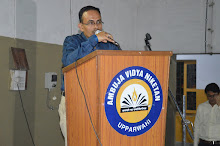Tips to prepare Notes and Summary:
Prepare notes using phrases only and never use complete
sentences.
The topic sentence of each paragraph is the main point and the
ideas affiliated to
it are the sub-points – one or more depending on the concepts in
the paragraph.
Sub points should be limited to five.
Each sub-point may or may not have supplementary ideas which
become subsub points.
Proper indentation is essential.
Provide an appropriate title for the notes and the summary.
Include a minimum of 4 to 6 distinctly different, recognizable
short forms of the
Longer Words (abbreviations) in the notes.
Underline all short forms. Provide the key for the short forms
at the end of the
notes titled ‘Key to Abbreviations’.
Cover all the important points in the passage while preparing
the notes.
Identify and club similar ideas scattered in different
paragraphs/areas of the
Passage before subtitling paragraph wise to make note short and
precise.
Do proper indentation . You may use symbols & figures also for
abbreviation.
Include all the important points in the notes meaningfully to
prepare the
summary in about 80
Write the summary in complete sentences in a paragraph with a
suitable title.
Split up of Marks
Note making (5) Summary (3)
Title: 1 Content: 3
Key to Abbreviations: 1
Content: 2 Expression: 1
Passage for Note Making (Solved)
2. This small temple
captivates with the beauty and vitality of its detailed sculpture, covering almost
every inch of the walls, pillars and even ceilings. It has three shikharas and
stands on a star-shaped, raised platform with 24 edges. The outer walls have a
profusion of detailed carvings: the entire surface run over by carved plaques
of stone. There were vertical panels covered by exquisite figures of gods and
goddesses with many incarnations being depicted.
There were nymphs too, some carrying an ear of maize a symbol of
plenty and prosperity. The elaborate ornamentation, very characteristic of
Hoyasala sculptures, was a remarkable feature. On closer look- and it is worth
it – the series of friezes on the outer walls revealed intricately carved
caparisoned (covered decorative cloth) elephants, charging horsemen, stylized
flowers, warriors, musicians, crocodiles, and swans.
village after himself), the minister of the Hoyasala king,
Narasimha, the Third. The temple was built to house three versions of Krishna.
corridors each ending in a shrine, one for each kind of Krishna –
Venugopala, Janardana and
Prasanna Keshava, though only two remain in their original form.
In the darkness of the
sanctum sanctorum, I tried to discern the different images. The
temple’s sculptural perfection is amazing and it includes the doors of the
temple and the three elegantly carved towers.
and sub-headings. Use recognizable abbreviations, wherever necessary. Give the passage
a suitable title. 5
1.1. Detailed sculpture – covering walls, pillars, ceilings
1.1. a. Series of friezes on outer walls
1.1. b. intricately carved elephants
1.1. c. charging horsemen
1.1. d. stylized flowers
1.1. e. warriors, musicians, crocodile and swans
1.2. three shikharas – stands *shaped, raised platform – 24
edges
1.3. the outer walls – detailed carvings
1.4. the entire surface – carved plaques of stone
1.5. vertical panels covered by exq. fig.
2.1. incarnations
2.2. many deities
3. Temple in the History
3.1. comsnd. Soma Dandanayaka or Somnath
3.2. the inner center of the temple – kalyana mandapa
3.3. three corridors ending in a shrine
1. * star
2. exq exquisite
3. fig figures
4. comsnd. commissioned
2.2. Write a summary of the note prepared in not more than 80 words. (3
marks)
Temple of
Somnathpur
The
temple of Somnathpur is extraordinary due to the sculptures on the walls,
pillars,
and even the ceiling which is covered by exquisite figures of gods and
goddesses.
It is a representation of Hinduism with its many incarnations and
deities. The temple commissioned by Somnath
has a ‘kalyana mandapa’ with three
corridors
ending in a shrine.





0 Comment to "Tips to prepare Notes and Summary:"
Post a Comment